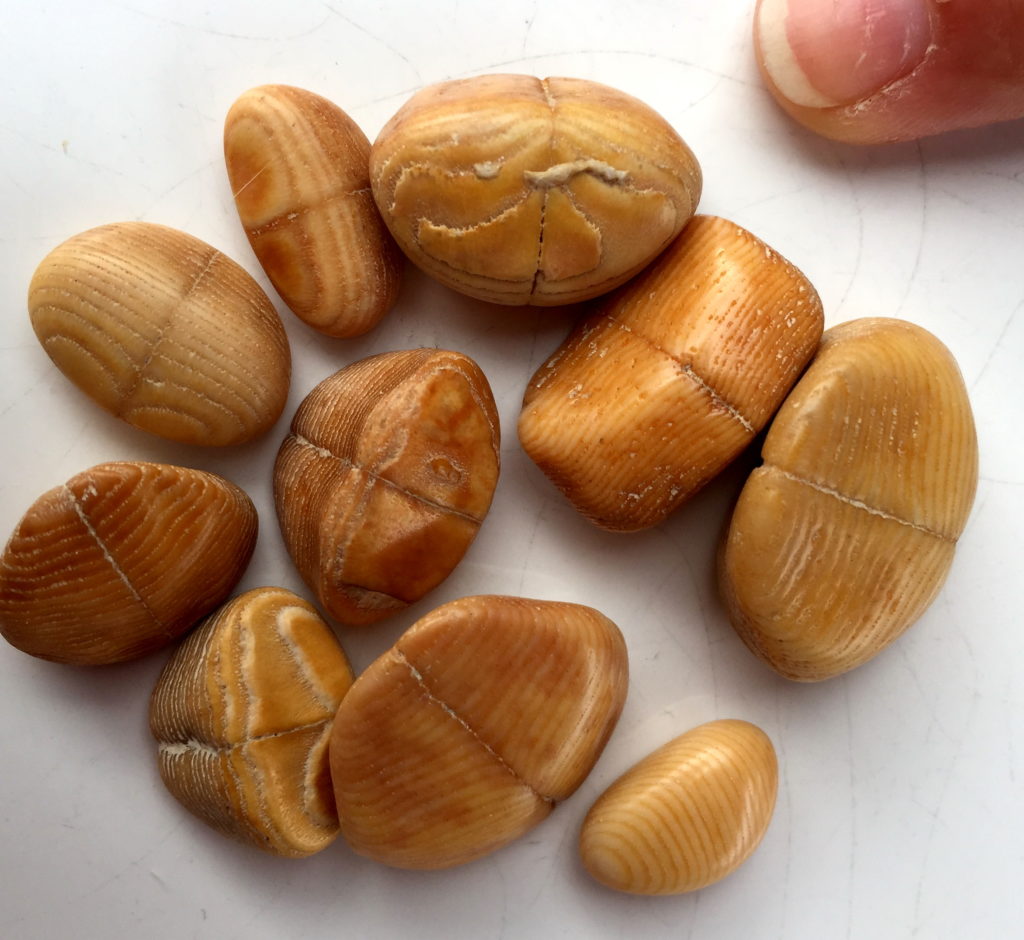Published in the Ocean Watch column, Honolulu Star-Advertiser © Susan Scott
March 18, 2017
Last week, reader Chris emailed a photo of some caramel-colored nuggets that she and husband Matt found along a North Shore coastline. Some of the pebblelike pieces are symmetrical, with a centerline. Others are halves of these, and all bear the markings of former ridges.
The ocean had rotated and polished the stony bits into jewels, lovely as the gemstones we call tiger’s-eye. Chris wondered if I knew what they were. I did not — and the search was on. Chris, Matt and I looked in books, queried friends and searched the internet.
 It’s still unknown how these porcupinefish palates found on the North Shore
It’s still unknown how these porcupinefish palates found on the North Shore
by a reader change color from white to shades of amber.
©2017 Susan Scott
The couple’s friend guessed their finds might be parts of parrotfish throats, called pharyngeal mills, that grind up coral rock. They aren’t, but it gave Chris and Matt a search subject that produced a link from Sydney’s Australian Museum. Pictured there is what the museum identified as a spiny pufferfish palate from a beach in the Gulf of Carpentaria.
Hawaii hosts a pufferfish with spines that we call a porcupinefish. The largest grows to a whopping 28 inches long and weighs 17 pounds, 12 ounces (the state record).
Chris and Matt wondered why porcupinefish mouth parts would be concentrated in one area of a long beach.
It’s possible that porcupinefish are abundant in that part of the ocean, but it’s more likely that the deposits are a result of coastal currents. The ocean sorts pebbles and shells according to flow strength, shoreline shape and objects’ weights, and that area is where the water drops off its palates.
I wondered why the roof of the mouth of the big prickly fish outlasts other parts of its skeleton, but I didn’t wonder for long. I have found dead, desiccated porcupinefish on beaches and brought them home.
When I picked one up to examine its palate, the whole thing fell apart, jaw bones included. That made clear that the fish’s upper tooth, shaped like a curved razor, is fused to a ribbed rock-hard palate. The same-shaped lower tooth is also fused to an identical hard floor, an upside-down palate. Both are bone white.
Apparently, after a pufferfish dies, ocean tumbling wears away its softer bones and teeth, leaving only the solid, durable plates. Where they get their rich color is a mystery.
Porcupinefish use their formidable teeth and rock-hard palates to crush snails, sea urchins and crabs. Be wary of a trapped porcupinefish. If caught or cornered, the fish can easily take off a finger, bone and all. Of the fresh bite I once saw, the remaining forefinger was sliced as clean across as if done with a cleaver.
Chris and Matt invited me to come see their pufferfish palates and, seeing my awe, generously gave me a few. Forget diamonds, rubies and sapphires. For us, porcupinefish palates are far more precious than stones.